Online Learning in Australian Secondary Schools: A Sociology Report
VerifiedAdded on 2023/01/18
|22
|5434
|45
Report
AI Summary
This report delves into the advantages and disadvantages of online learning within Australian secondary schools. It begins by highlighting the increasing prevalence of technology in education and its impact on teaching methodologies. The research investigates the benefits, such as improved interaction and access to resources, and the challenges, including difficulties with technology access and the potential for educational malpractices. The methodology involves the analysis of 12 sources, including articles and journals, using keywords to identify relevant studies published between 2010 and 2019. The analysis reveals both positive and negative impacts, such as the benefits of learning at one's own pace and the challenges of digital divides and pedagogical skills of online teachers. The report concludes by summarizing the findings and discussing the implications of online learning for the future of secondary education in Australia.
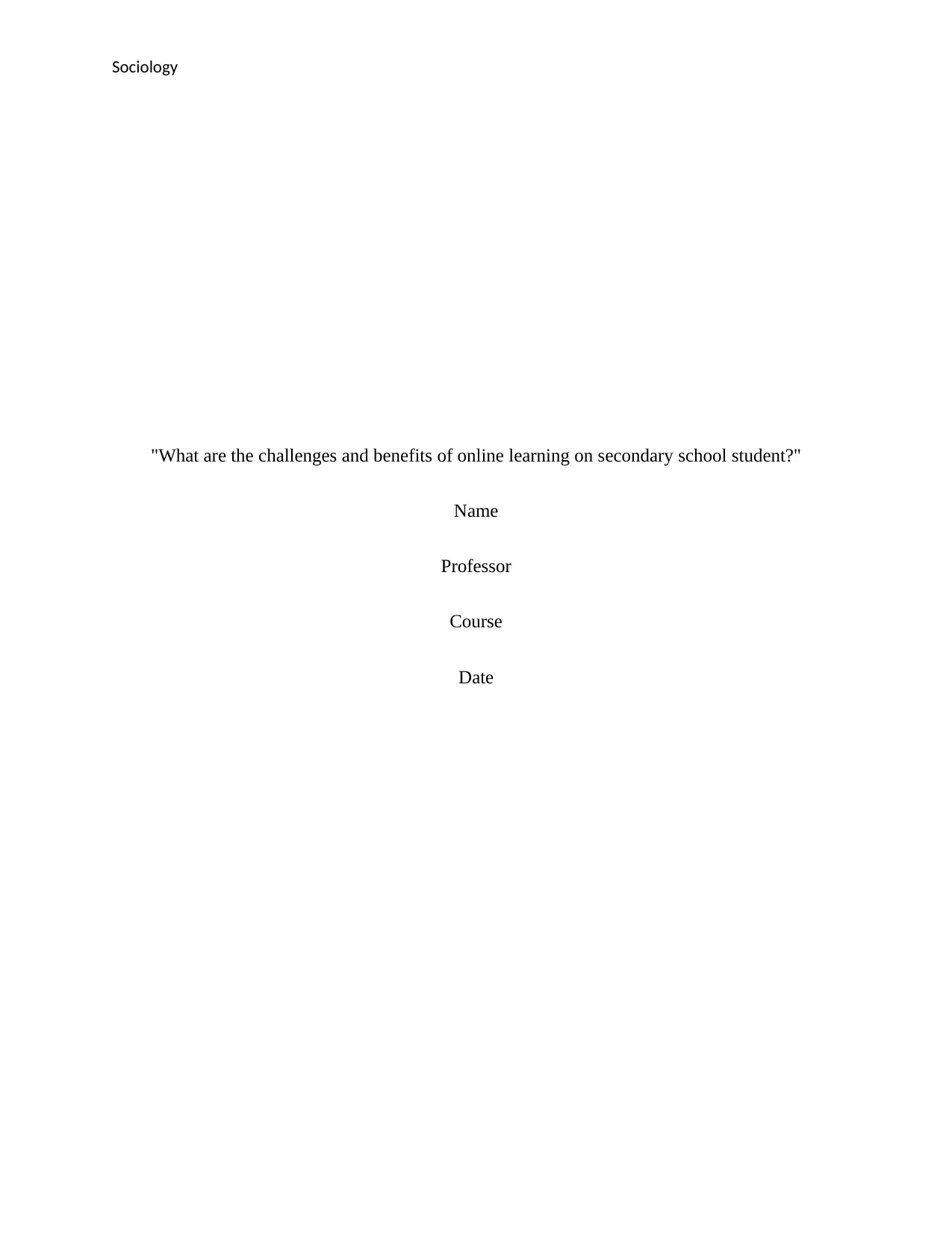
Sociology
"What are the challenges and benefits of online learning on secondary school student?"
Name
Professor
Course
Date
"What are the challenges and benefits of online learning on secondary school student?"
Name
Professor
Course
Date
Paraphrase This Document
Need a fresh take? Get an instant paraphrase of this document with our AI Paraphraser
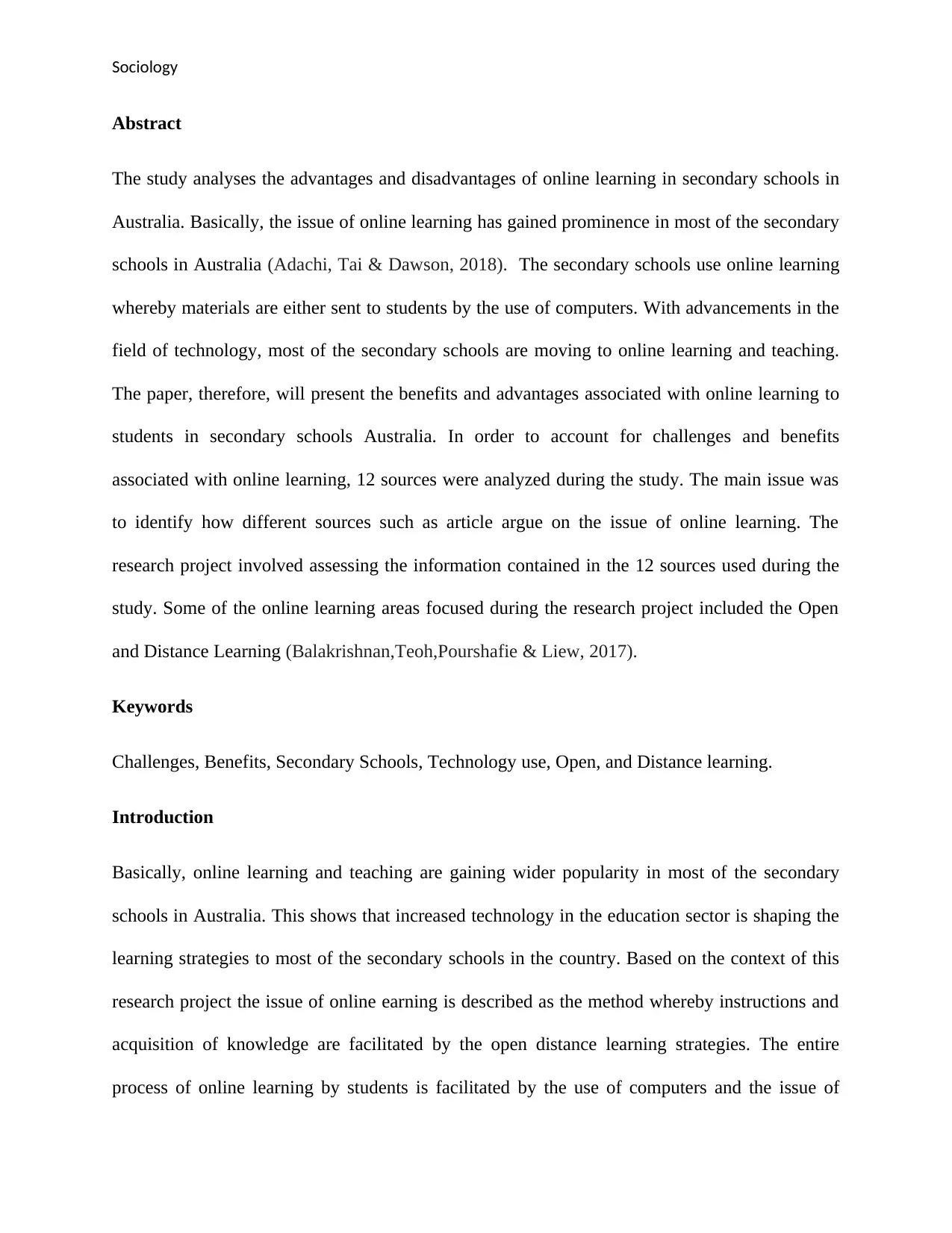
Sociology
Abstract
The study analyses the advantages and disadvantages of online learning in secondary schools in
Australia. Basically, the issue of online learning has gained prominence in most of the secondary
schools in Australia (Adachi, Tai & Dawson, 2018). The secondary schools use online learning
whereby materials are either sent to students by the use of computers. With advancements in the
field of technology, most of the secondary schools are moving to online learning and teaching.
The paper, therefore, will present the benefits and advantages associated with online learning to
students in secondary schools Australia. In order to account for challenges and benefits
associated with online learning, 12 sources were analyzed during the study. The main issue was
to identify how different sources such as article argue on the issue of online learning. The
research project involved assessing the information contained in the 12 sources used during the
study. Some of the online learning areas focused during the research project included the Open
and Distance Learning (Balakrishnan,Teoh,Pourshafie & Liew, 2017).
Keywords
Challenges, Benefits, Secondary Schools, Technology use, Open, and Distance learning.
Introduction
Basically, online learning and teaching are gaining wider popularity in most of the secondary
schools in Australia. This shows that increased technology in the education sector is shaping the
learning strategies to most of the secondary schools in the country. Based on the context of this
research project the issue of online earning is described as the method whereby instructions and
acquisition of knowledge are facilitated by the open distance learning strategies. The entire
process of online learning by students is facilitated by the use of computers and the issue of
Abstract
The study analyses the advantages and disadvantages of online learning in secondary schools in
Australia. Basically, the issue of online learning has gained prominence in most of the secondary
schools in Australia (Adachi, Tai & Dawson, 2018). The secondary schools use online learning
whereby materials are either sent to students by the use of computers. With advancements in the
field of technology, most of the secondary schools are moving to online learning and teaching.
The paper, therefore, will present the benefits and advantages associated with online learning to
students in secondary schools Australia. In order to account for challenges and benefits
associated with online learning, 12 sources were analyzed during the study. The main issue was
to identify how different sources such as article argue on the issue of online learning. The
research project involved assessing the information contained in the 12 sources used during the
study. Some of the online learning areas focused during the research project included the Open
and Distance Learning (Balakrishnan,Teoh,Pourshafie & Liew, 2017).
Keywords
Challenges, Benefits, Secondary Schools, Technology use, Open, and Distance learning.
Introduction
Basically, online learning and teaching are gaining wider popularity in most of the secondary
schools in Australia. This shows that increased technology in the education sector is shaping the
learning strategies to most of the secondary schools in the country. Based on the context of this
research project the issue of online earning is described as the method whereby instructions and
acquisition of knowledge are facilitated by the open distance learning strategies. The entire
process of online learning by students is facilitated by the use of computers and the issue of
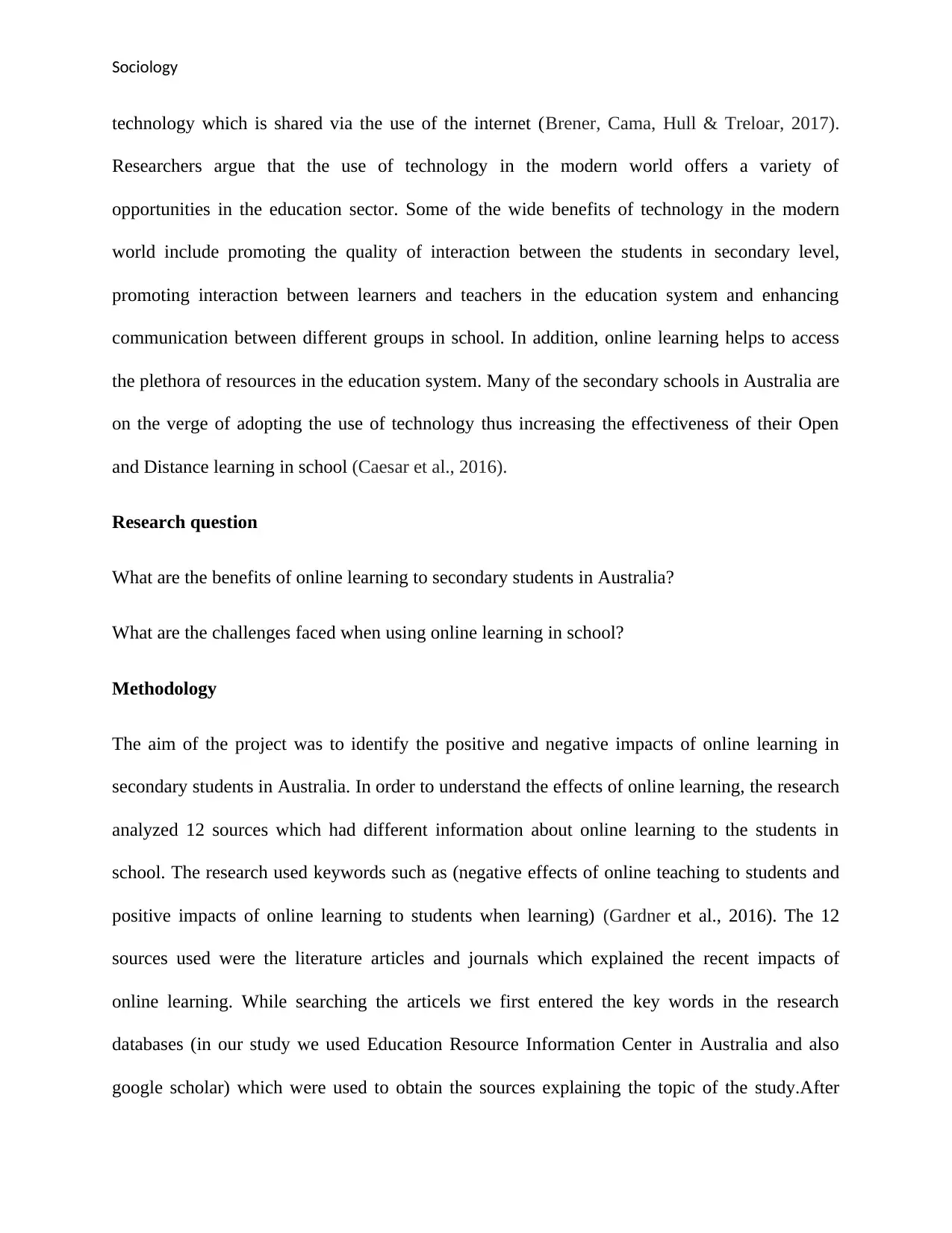
Sociology
technology which is shared via the use of the internet (Brener, Cama, Hull & Treloar, 2017).
Researchers argue that the use of technology in the modern world offers a variety of
opportunities in the education sector. Some of the wide benefits of technology in the modern
world include promoting the quality of interaction between the students in secondary level,
promoting interaction between learners and teachers in the education system and enhancing
communication between different groups in school. In addition, online learning helps to access
the plethora of resources in the education system. Many of the secondary schools in Australia are
on the verge of adopting the use of technology thus increasing the effectiveness of their Open
and Distance learning in school (Caesar et al., 2016).
Research question
What are the benefits of online learning to secondary students in Australia?
What are the challenges faced when using online learning in school?
Methodology
The aim of the project was to identify the positive and negative impacts of online learning in
secondary students in Australia. In order to understand the effects of online learning, the research
analyzed 12 sources which had different information about online learning to the students in
school. The research used keywords such as (negative effects of online teaching to students and
positive impacts of online learning to students when learning) (Gardner et al., 2016). The 12
sources used were the literature articles and journals which explained the recent impacts of
online learning. While searching the articels we first entered the key words in the research
databases (in our study we used Education Resource Information Center in Australia and also
google scholar) which were used to obtain the sources explaining the topic of the study.After
technology which is shared via the use of the internet (Brener, Cama, Hull & Treloar, 2017).
Researchers argue that the use of technology in the modern world offers a variety of
opportunities in the education sector. Some of the wide benefits of technology in the modern
world include promoting the quality of interaction between the students in secondary level,
promoting interaction between learners and teachers in the education system and enhancing
communication between different groups in school. In addition, online learning helps to access
the plethora of resources in the education system. Many of the secondary schools in Australia are
on the verge of adopting the use of technology thus increasing the effectiveness of their Open
and Distance learning in school (Caesar et al., 2016).
Research question
What are the benefits of online learning to secondary students in Australia?
What are the challenges faced when using online learning in school?
Methodology
The aim of the project was to identify the positive and negative impacts of online learning in
secondary students in Australia. In order to understand the effects of online learning, the research
analyzed 12 sources which had different information about online learning to the students in
school. The research used keywords such as (negative effects of online teaching to students and
positive impacts of online learning to students when learning) (Gardner et al., 2016). The 12
sources used were the literature articles and journals which explained the recent impacts of
online learning. While searching the articels we first entered the key words in the research
databases (in our study we used Education Resource Information Center in Australia and also
google scholar) which were used to obtain the sources explaining the topic of the study.After
⊘ This is a preview!⊘
Do you want full access?
Subscribe today to unlock all pages.

Trusted by 1+ million students worldwide
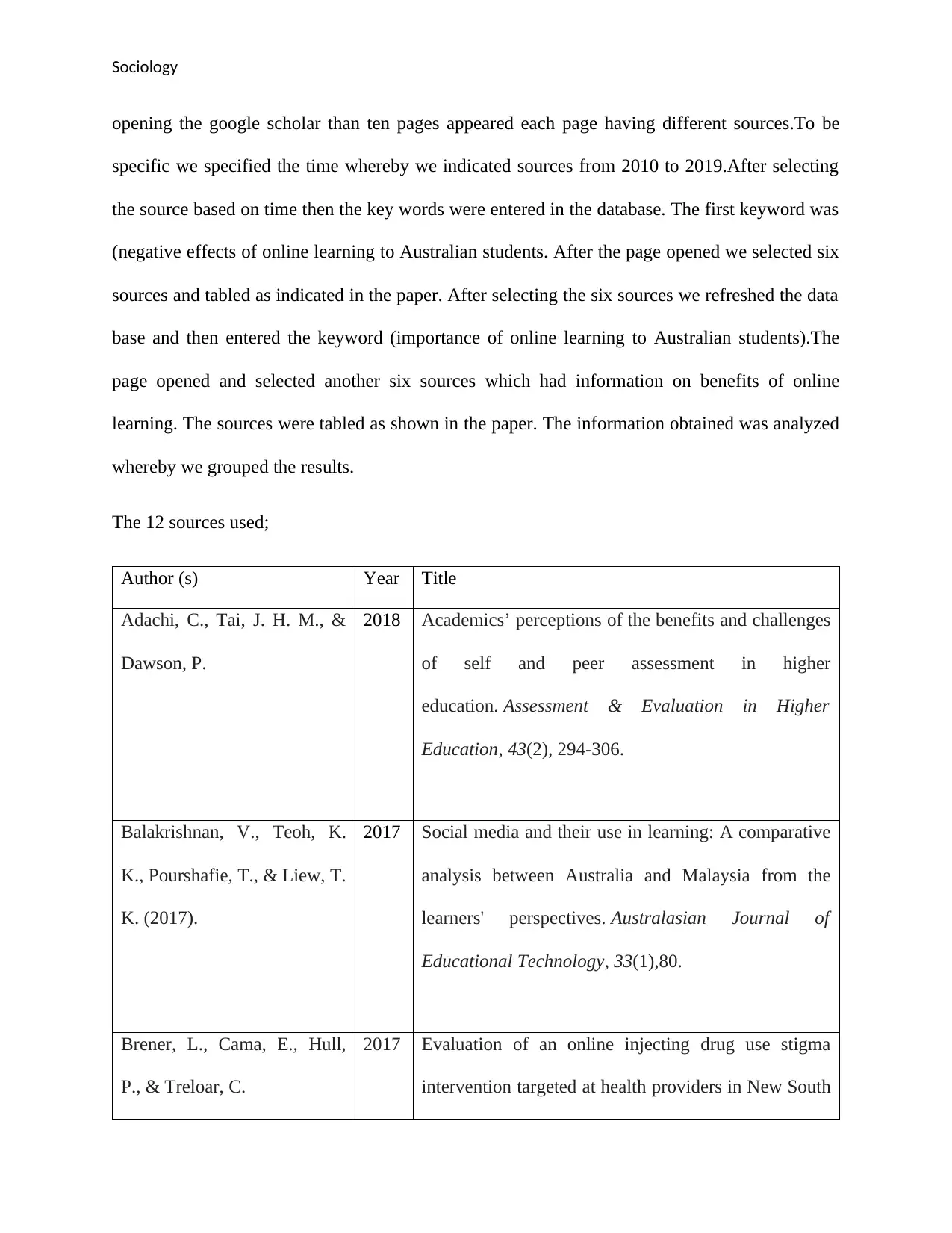
Sociology
opening the google scholar than ten pages appeared each page having different sources.To be
specific we specified the time whereby we indicated sources from 2010 to 2019.After selecting
the source based on time then the key words were entered in the database. The first keyword was
(negative effects of online learning to Australian students. After the page opened we selected six
sources and tabled as indicated in the paper. After selecting the six sources we refreshed the data
base and then entered the keyword (importance of online learning to Australian students).The
page opened and selected another six sources which had information on benefits of online
learning. The sources were tabled as shown in the paper. The information obtained was analyzed
whereby we grouped the results.
The 12 sources used;
Author (s) Year Title
Adachi, C., Tai, J. H. M., &
Dawson, P.
2018 Academics’ perceptions of the benefits and challenges
of self and peer assessment in higher
education. Assessment & Evaluation in Higher
Education, 43(2), 294-306.
Balakrishnan, V., Teoh, K.
K., Pourshafie, T., & Liew, T.
K. (2017).
2017 Social media and their use in learning: A comparative
analysis between Australia and Malaysia from the
learners' perspectives. Australasian Journal of
Educational Technology, 33(1),80.
Brener, L., Cama, E., Hull,
P., & Treloar, C.
2017 Evaluation of an online injecting drug use stigma
intervention targeted at health providers in New South
opening the google scholar than ten pages appeared each page having different sources.To be
specific we specified the time whereby we indicated sources from 2010 to 2019.After selecting
the source based on time then the key words were entered in the database. The first keyword was
(negative effects of online learning to Australian students. After the page opened we selected six
sources and tabled as indicated in the paper. After selecting the six sources we refreshed the data
base and then entered the keyword (importance of online learning to Australian students).The
page opened and selected another six sources which had information on benefits of online
learning. The sources were tabled as shown in the paper. The information obtained was analyzed
whereby we grouped the results.
The 12 sources used;
Author (s) Year Title
Adachi, C., Tai, J. H. M., &
Dawson, P.
2018 Academics’ perceptions of the benefits and challenges
of self and peer assessment in higher
education. Assessment & Evaluation in Higher
Education, 43(2), 294-306.
Balakrishnan, V., Teoh, K.
K., Pourshafie, T., & Liew, T.
K. (2017).
2017 Social media and their use in learning: A comparative
analysis between Australia and Malaysia from the
learners' perspectives. Australasian Journal of
Educational Technology, 33(1),80.
Brener, L., Cama, E., Hull,
P., & Treloar, C.
2017 Evaluation of an online injecting drug use stigma
intervention targeted at health providers in New South
Paraphrase This Document
Need a fresh take? Get an instant paraphrase of this document with our AI Paraphraser
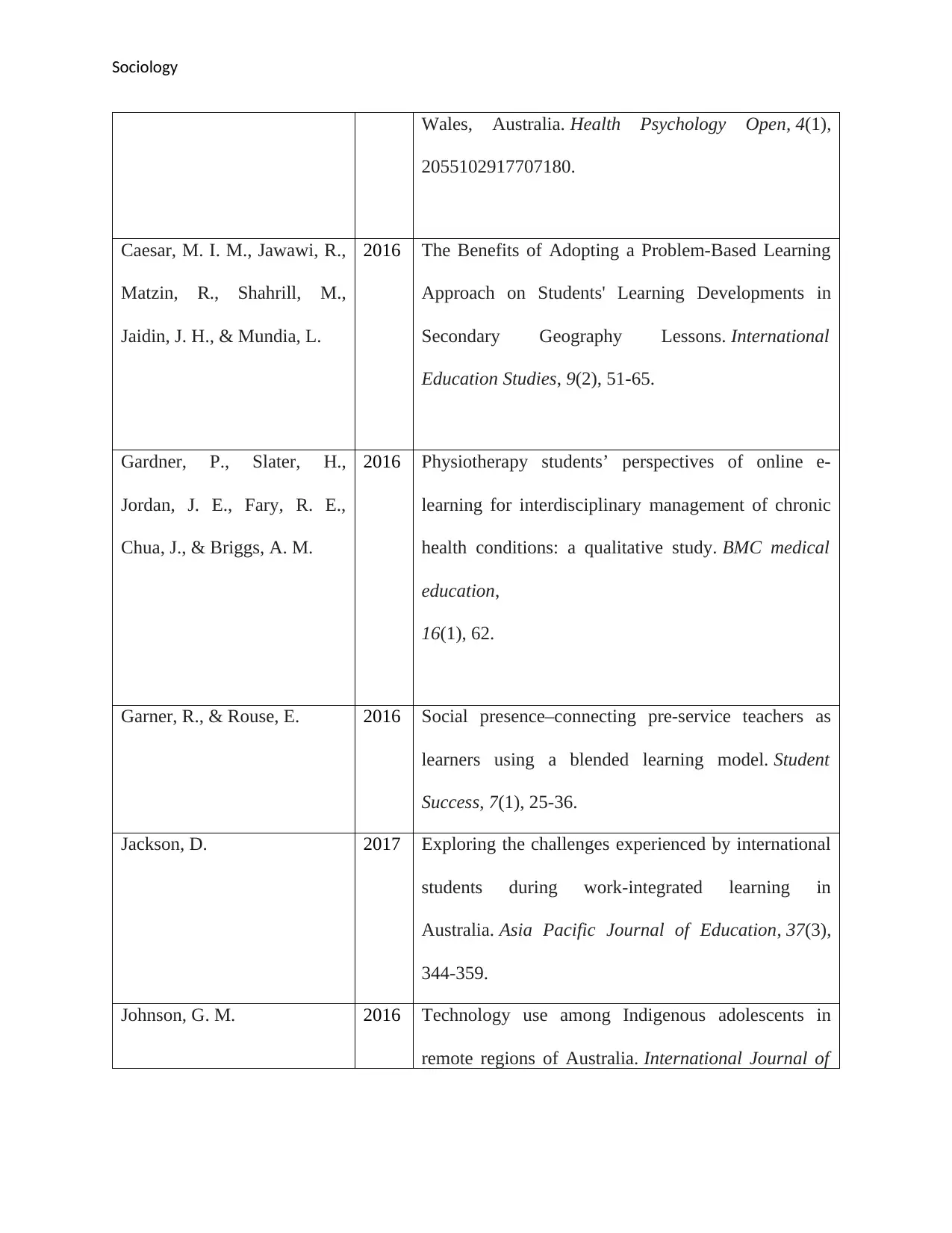
Sociology
Wales, Australia. Health Psychology Open, 4(1),
2055102917707180.
Caesar, M. I. M., Jawawi, R.,
Matzin, R., Shahrill, M.,
Jaidin, J. H., & Mundia, L.
2016 The Benefits of Adopting a Problem-Based Learning
Approach on Students' Learning Developments in
Secondary Geography Lessons. International
Education Studies, 9(2), 51-65.
Gardner, P., Slater, H.,
Jordan, J. E., Fary, R. E.,
Chua, J., & Briggs, A. M.
2016 Physiotherapy students’ perspectives of online e-
learning for interdisciplinary management of chronic
health conditions: a qualitative study. BMC medical
education,
16(1), 62.
Garner, R., & Rouse, E. 2016 Social presence–connecting pre-service teachers as
learners using a blended learning model. Student
Success, 7(1), 25-36.
Jackson, D. 2017 Exploring the challenges experienced by international
students during work-integrated learning in
Australia. Asia Pacific Journal of Education, 37(3),
344-359.
Johnson, G. M. 2016 Technology use among Indigenous adolescents in
remote regions of Australia. International Journal of
Wales, Australia. Health Psychology Open, 4(1),
2055102917707180.
Caesar, M. I. M., Jawawi, R.,
Matzin, R., Shahrill, M.,
Jaidin, J. H., & Mundia, L.
2016 The Benefits of Adopting a Problem-Based Learning
Approach on Students' Learning Developments in
Secondary Geography Lessons. International
Education Studies, 9(2), 51-65.
Gardner, P., Slater, H.,
Jordan, J. E., Fary, R. E.,
Chua, J., & Briggs, A. M.
2016 Physiotherapy students’ perspectives of online e-
learning for interdisciplinary management of chronic
health conditions: a qualitative study. BMC medical
education,
16(1), 62.
Garner, R., & Rouse, E. 2016 Social presence–connecting pre-service teachers as
learners using a blended learning model. Student
Success, 7(1), 25-36.
Jackson, D. 2017 Exploring the challenges experienced by international
students during work-integrated learning in
Australia. Asia Pacific Journal of Education, 37(3),
344-359.
Johnson, G. M. 2016 Technology use among Indigenous adolescents in
remote regions of Australia. International Journal of
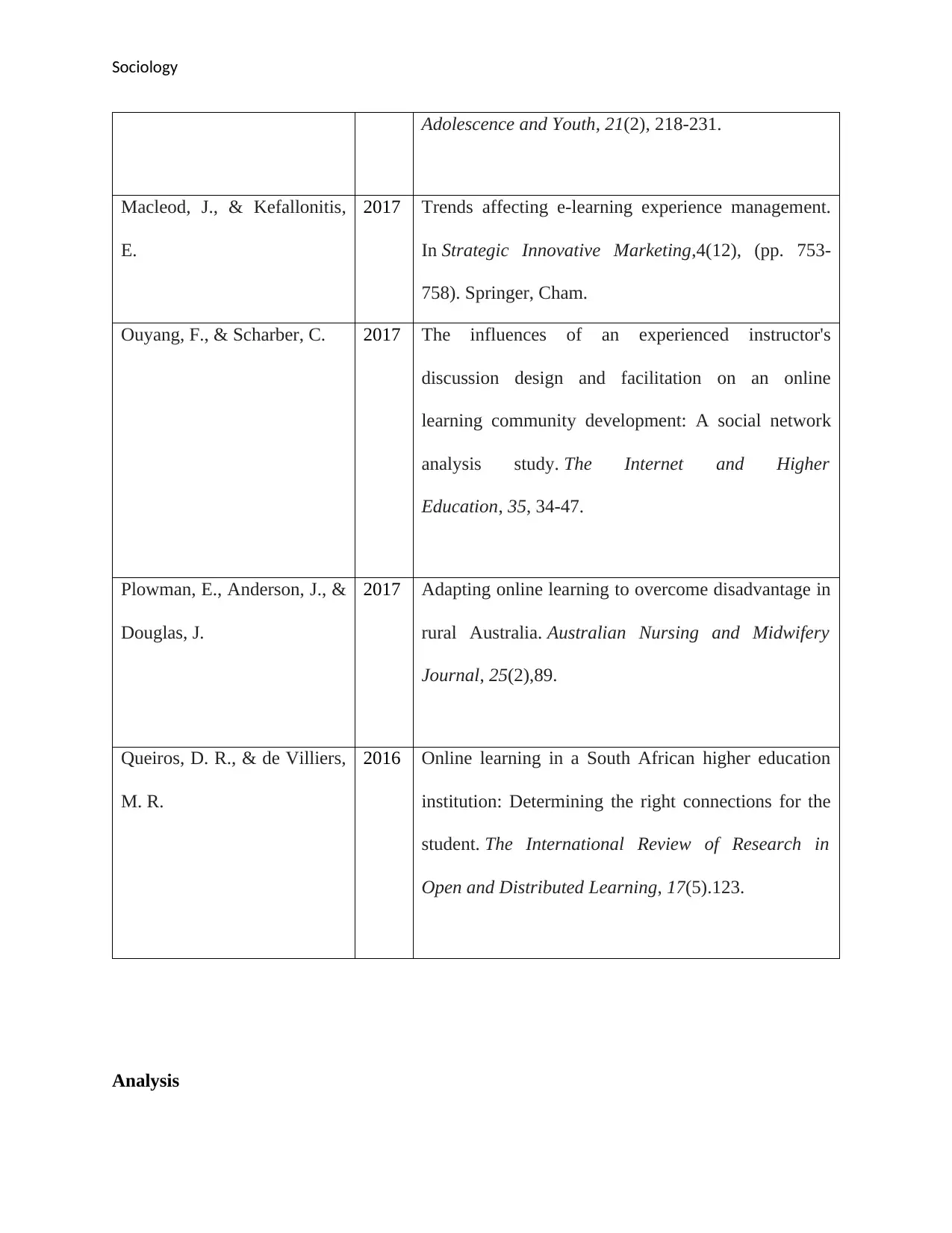
Sociology
Adolescence and Youth, 21(2), 218-231.
Macleod, J., & Kefallonitis,
E.
2017 Trends affecting e-learning experience management.
In Strategic Innovative Marketing,4(12), (pp. 753-
758). Springer, Cham.
Ouyang, F., & Scharber, C. 2017 The influences of an experienced instructor's
discussion design and facilitation on an online
learning community development: A social network
analysis study. The Internet and Higher
Education, 35, 34-47.
Plowman, E., Anderson, J., &
Douglas, J.
2017 Adapting online learning to overcome disadvantage in
rural Australia. Australian Nursing and Midwifery
Journal, 25(2),89.
Queiros, D. R., & de Villiers,
M. R.
2016 Online learning in a South African higher education
institution: Determining the right connections for the
student. The International Review of Research in
Open and Distributed Learning, 17(5).123.
Analysis
Adolescence and Youth, 21(2), 218-231.
Macleod, J., & Kefallonitis,
E.
2017 Trends affecting e-learning experience management.
In Strategic Innovative Marketing,4(12), (pp. 753-
758). Springer, Cham.
Ouyang, F., & Scharber, C. 2017 The influences of an experienced instructor's
discussion design and facilitation on an online
learning community development: A social network
analysis study. The Internet and Higher
Education, 35, 34-47.
Plowman, E., Anderson, J., &
Douglas, J.
2017 Adapting online learning to overcome disadvantage in
rural Australia. Australian Nursing and Midwifery
Journal, 25(2),89.
Queiros, D. R., & de Villiers,
M. R.
2016 Online learning in a South African higher education
institution: Determining the right connections for the
student. The International Review of Research in
Open and Distributed Learning, 17(5).123.
Analysis
⊘ This is a preview!⊘
Do you want full access?
Subscribe today to unlock all pages.

Trusted by 1+ million students worldwide
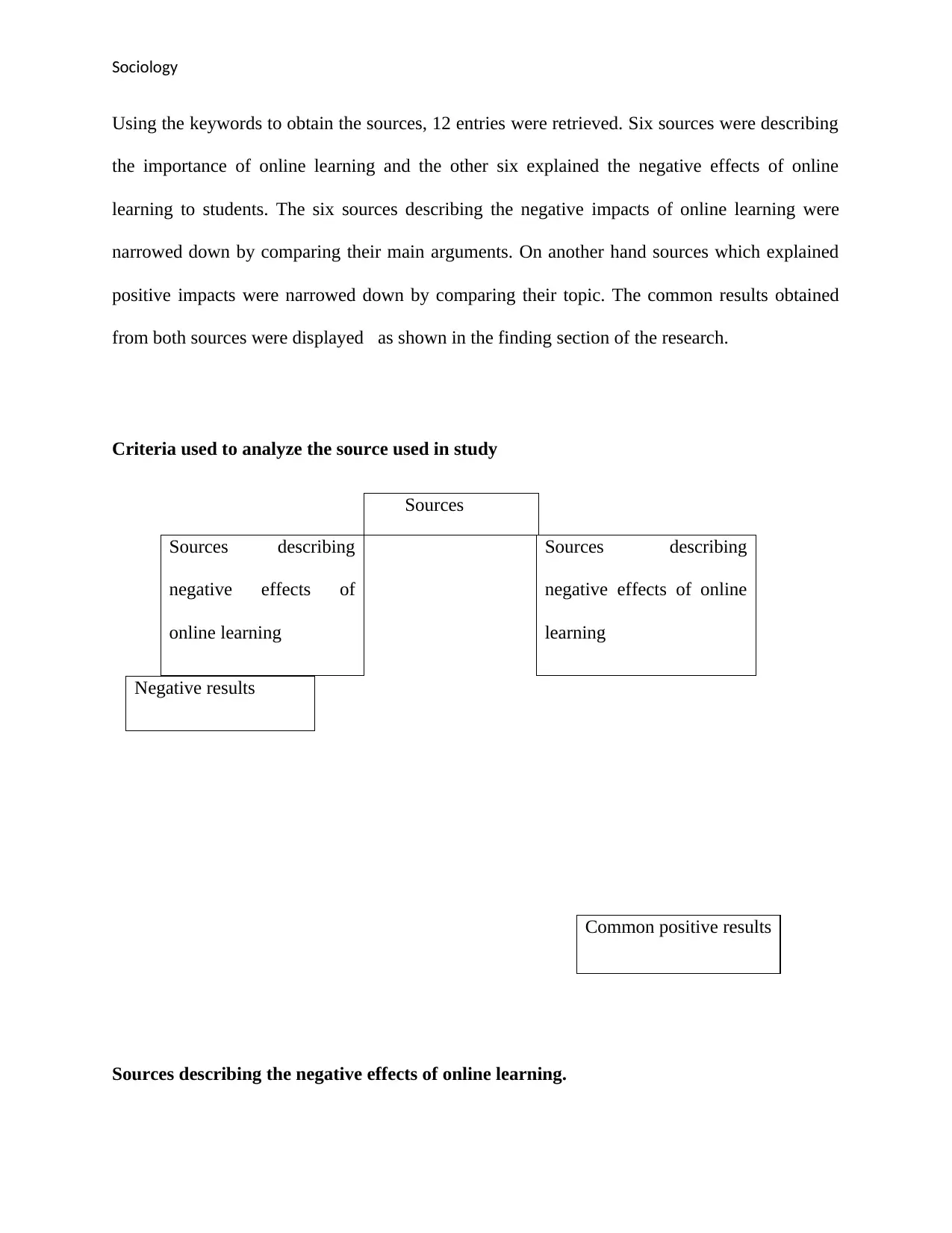
Sociology
Using the keywords to obtain the sources, 12 entries were retrieved. Six sources were describing
the importance of online learning and the other six explained the negative effects of online
learning to students. The six sources describing the negative impacts of online learning were
narrowed down by comparing their main arguments. On another hand sources which explained
positive impacts were narrowed down by comparing their topic. The common results obtained
from both sources were displayed as shown in the finding section of the research.
Criteria used to analyze the source used in study
Sources
Sources describing
negative effects of
online learning
Sources describing
negative effects of online
learning
Negative results
Sources describing the negative effects of online learning.
Common positive results
Using the keywords to obtain the sources, 12 entries were retrieved. Six sources were describing
the importance of online learning and the other six explained the negative effects of online
learning to students. The six sources describing the negative impacts of online learning were
narrowed down by comparing their main arguments. On another hand sources which explained
positive impacts were narrowed down by comparing their topic. The common results obtained
from both sources were displayed as shown in the finding section of the research.
Criteria used to analyze the source used in study
Sources
Sources describing
negative effects of
online learning
Sources describing
negative effects of online
learning
Negative results
Sources describing the negative effects of online learning.
Common positive results
Paraphrase This Document
Need a fresh take? Get an instant paraphrase of this document with our AI Paraphraser
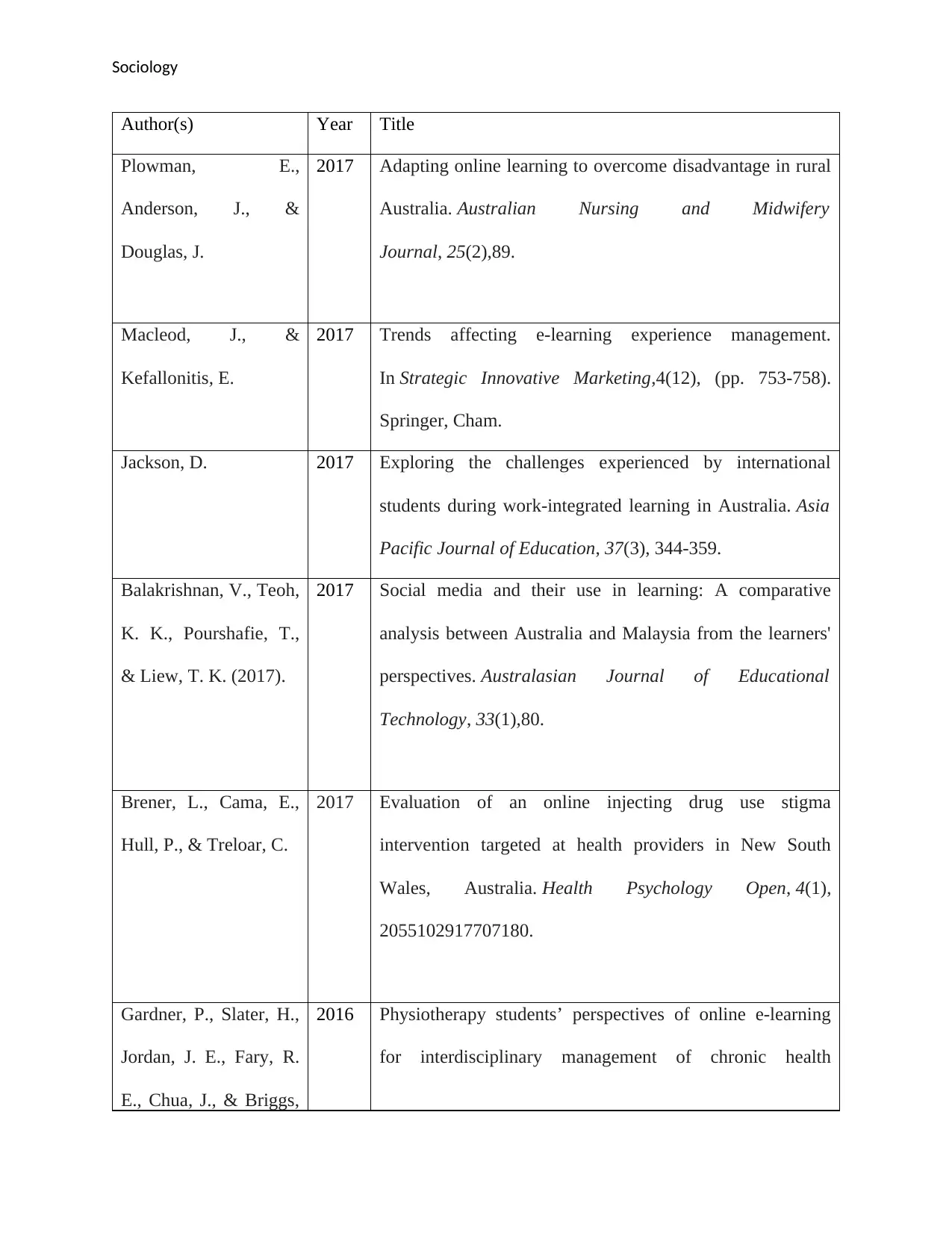
Sociology
Author(s) Year Title
Plowman, E.,
Anderson, J., &
Douglas, J.
2017 Adapting online learning to overcome disadvantage in rural
Australia. Australian Nursing and Midwifery
Journal, 25(2),89.
Macleod, J., &
Kefallonitis, E.
2017 Trends affecting e-learning experience management.
In Strategic Innovative Marketing,4(12), (pp. 753-758).
Springer, Cham.
Jackson, D. 2017 Exploring the challenges experienced by international
students during work-integrated learning in Australia. Asia
Pacific Journal of Education, 37(3), 344-359.
Balakrishnan, V., Teoh,
K. K., Pourshafie, T.,
& Liew, T. K. (2017).
2017 Social media and their use in learning: A comparative
analysis between Australia and Malaysia from the learners'
perspectives. Australasian Journal of Educational
Technology, 33(1),80.
Brener, L., Cama, E.,
Hull, P., & Treloar, C.
2017 Evaluation of an online injecting drug use stigma
intervention targeted at health providers in New South
Wales, Australia. Health Psychology Open, 4(1),
2055102917707180.
Gardner, P., Slater, H.,
Jordan, J. E., Fary, R.
E., Chua, J., & Briggs,
2016 Physiotherapy students’ perspectives of online e-learning
for interdisciplinary management of chronic health
Author(s) Year Title
Plowman, E.,
Anderson, J., &
Douglas, J.
2017 Adapting online learning to overcome disadvantage in rural
Australia. Australian Nursing and Midwifery
Journal, 25(2),89.
Macleod, J., &
Kefallonitis, E.
2017 Trends affecting e-learning experience management.
In Strategic Innovative Marketing,4(12), (pp. 753-758).
Springer, Cham.
Jackson, D. 2017 Exploring the challenges experienced by international
students during work-integrated learning in Australia. Asia
Pacific Journal of Education, 37(3), 344-359.
Balakrishnan, V., Teoh,
K. K., Pourshafie, T.,
& Liew, T. K. (2017).
2017 Social media and their use in learning: A comparative
analysis between Australia and Malaysia from the learners'
perspectives. Australasian Journal of Educational
Technology, 33(1),80.
Brener, L., Cama, E.,
Hull, P., & Treloar, C.
2017 Evaluation of an online injecting drug use stigma
intervention targeted at health providers in New South
Wales, Australia. Health Psychology Open, 4(1),
2055102917707180.
Gardner, P., Slater, H.,
Jordan, J. E., Fary, R.
E., Chua, J., & Briggs,
2016 Physiotherapy students’ perspectives of online e-learning
for interdisciplinary management of chronic health
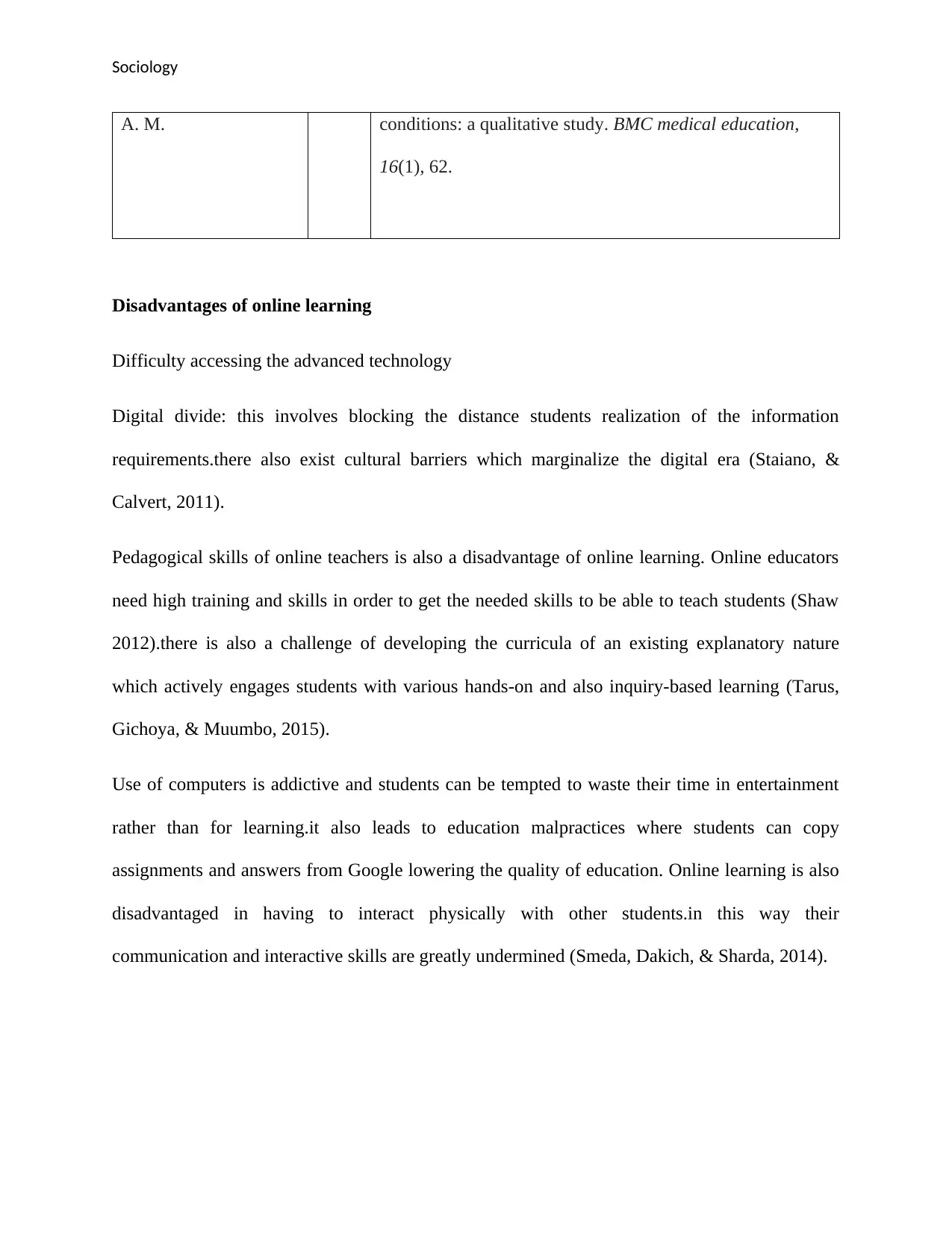
Sociology
A. M. conditions: a qualitative study. BMC medical education,
16(1), 62.
Disadvantages of online learning
Difficulty accessing the advanced technology
Digital divide: this involves blocking the distance students realization of the information
requirements.there also exist cultural barriers which marginalize the digital era (Staiano, &
Calvert, 2011).
Pedagogical skills of online teachers is also a disadvantage of online learning. Online educators
need high training and skills in order to get the needed skills to be able to teach students (Shaw
2012).there is also a challenge of developing the curricula of an existing explanatory nature
which actively engages students with various hands-on and also inquiry-based learning (Tarus,
Gichoya, & Muumbo, 2015).
Use of computers is addictive and students can be tempted to waste their time in entertainment
rather than for learning.it also leads to education malpractices where students can copy
assignments and answers from Google lowering the quality of education. Online learning is also
disadvantaged in having to interact physically with other students.in this way their
communication and interactive skills are greatly undermined (Smeda, Dakich, & Sharda, 2014).
A. M. conditions: a qualitative study. BMC medical education,
16(1), 62.
Disadvantages of online learning
Difficulty accessing the advanced technology
Digital divide: this involves blocking the distance students realization of the information
requirements.there also exist cultural barriers which marginalize the digital era (Staiano, &
Calvert, 2011).
Pedagogical skills of online teachers is also a disadvantage of online learning. Online educators
need high training and skills in order to get the needed skills to be able to teach students (Shaw
2012).there is also a challenge of developing the curricula of an existing explanatory nature
which actively engages students with various hands-on and also inquiry-based learning (Tarus,
Gichoya, & Muumbo, 2015).
Use of computers is addictive and students can be tempted to waste their time in entertainment
rather than for learning.it also leads to education malpractices where students can copy
assignments and answers from Google lowering the quality of education. Online learning is also
disadvantaged in having to interact physically with other students.in this way their
communication and interactive skills are greatly undermined (Smeda, Dakich, & Sharda, 2014).
⊘ This is a preview!⊘
Do you want full access?
Subscribe today to unlock all pages.

Trusted by 1+ million students worldwide
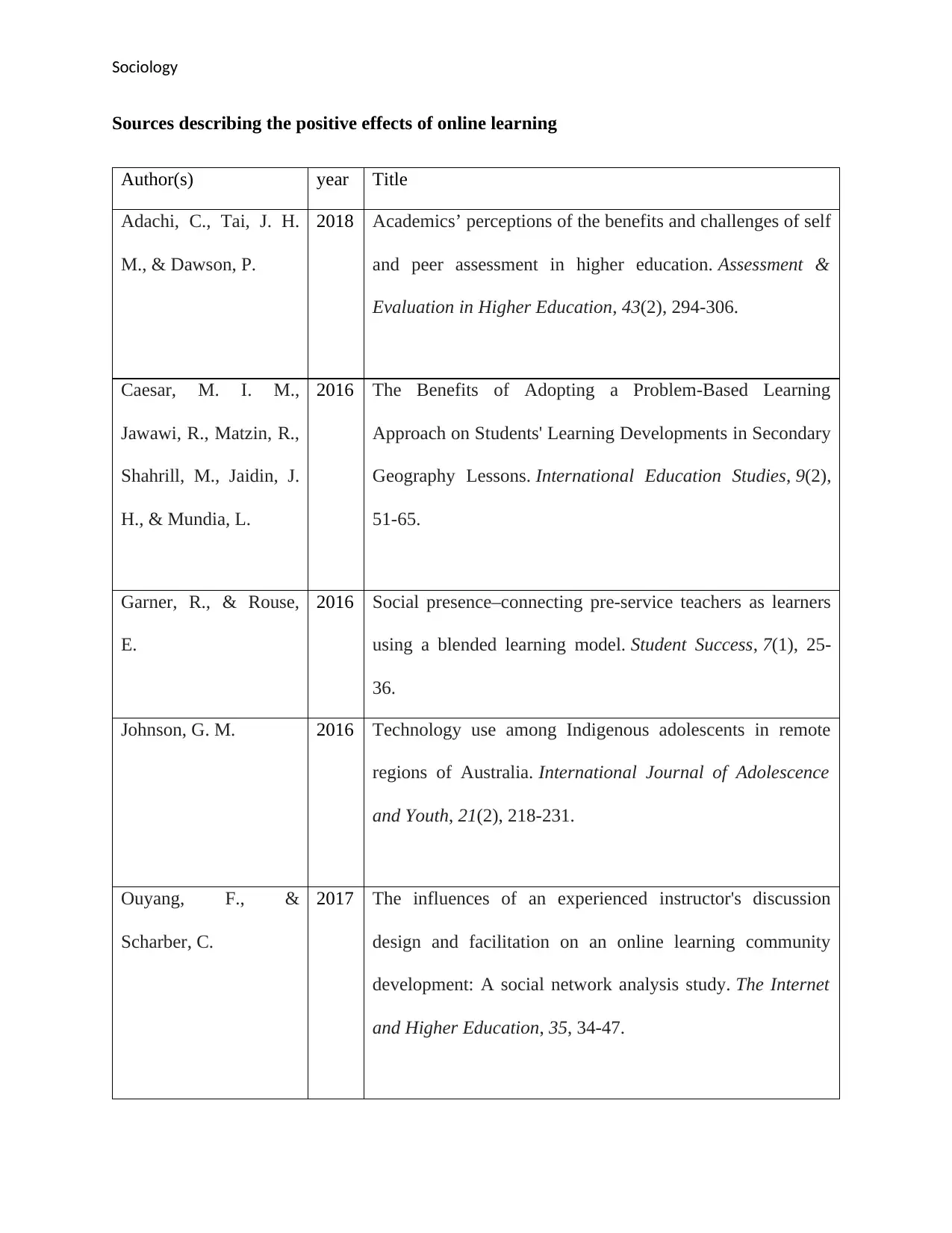
Sociology
Sources describing the positive effects of online learning
Author(s) year Title
Adachi, C., Tai, J. H.
M., & Dawson, P.
2018 Academics’ perceptions of the benefits and challenges of self
and peer assessment in higher education. Assessment &
Evaluation in Higher Education, 43(2), 294-306.
Caesar, M. I. M.,
Jawawi, R., Matzin, R.,
Shahrill, M., Jaidin, J.
H., & Mundia, L.
2016 The Benefits of Adopting a Problem-Based Learning
Approach on Students' Learning Developments in Secondary
Geography Lessons. International Education Studies, 9(2),
51-65.
Garner, R., & Rouse,
E.
2016 Social presence–connecting pre-service teachers as learners
using a blended learning model. Student Success, 7(1), 25-
36.
Johnson, G. M. 2016 Technology use among Indigenous adolescents in remote
regions of Australia. International Journal of Adolescence
and Youth, 21(2), 218-231.
Ouyang, F., &
Scharber, C.
2017 The influences of an experienced instructor's discussion
design and facilitation on an online learning community
development: A social network analysis study. The Internet
and Higher Education, 35, 34-47.
Sources describing the positive effects of online learning
Author(s) year Title
Adachi, C., Tai, J. H.
M., & Dawson, P.
2018 Academics’ perceptions of the benefits and challenges of self
and peer assessment in higher education. Assessment &
Evaluation in Higher Education, 43(2), 294-306.
Caesar, M. I. M.,
Jawawi, R., Matzin, R.,
Shahrill, M., Jaidin, J.
H., & Mundia, L.
2016 The Benefits of Adopting a Problem-Based Learning
Approach on Students' Learning Developments in Secondary
Geography Lessons. International Education Studies, 9(2),
51-65.
Garner, R., & Rouse,
E.
2016 Social presence–connecting pre-service teachers as learners
using a blended learning model. Student Success, 7(1), 25-
36.
Johnson, G. M. 2016 Technology use among Indigenous adolescents in remote
regions of Australia. International Journal of Adolescence
and Youth, 21(2), 218-231.
Ouyang, F., &
Scharber, C.
2017 The influences of an experienced instructor's discussion
design and facilitation on an online learning community
development: A social network analysis study. The Internet
and Higher Education, 35, 34-47.
Paraphrase This Document
Need a fresh take? Get an instant paraphrase of this document with our AI Paraphraser
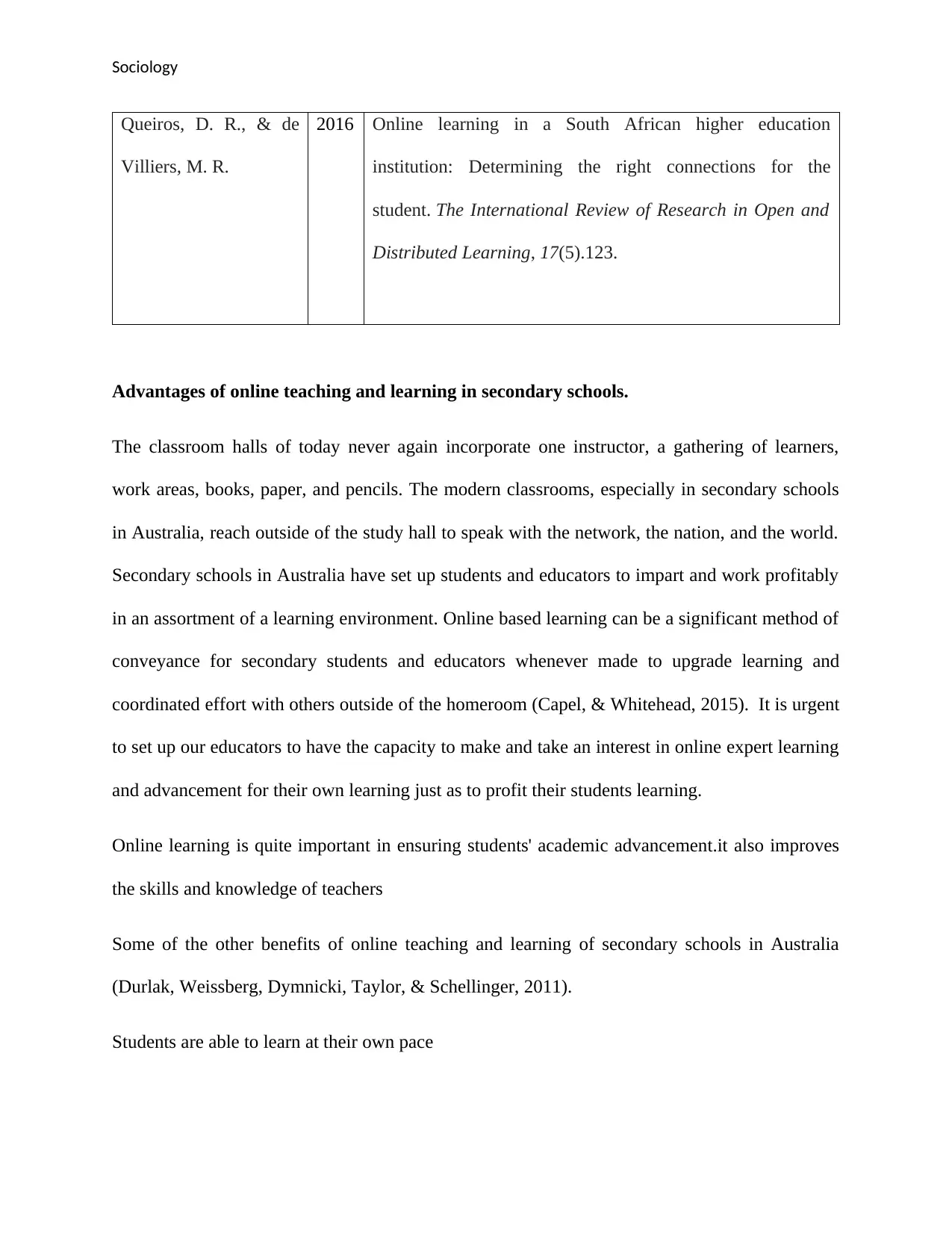
Sociology
Queiros, D. R., & de
Villiers, M. R.
2016 Online learning in a South African higher education
institution: Determining the right connections for the
student. The International Review of Research in Open and
Distributed Learning, 17(5).123.
Advantages of online teaching and learning in secondary schools.
The classroom halls of today never again incorporate one instructor, a gathering of learners,
work areas, books, paper, and pencils. The modern classrooms, especially in secondary schools
in Australia, reach outside of the study hall to speak with the network, the nation, and the world.
Secondary schools in Australia have set up students and educators to impart and work profitably
in an assortment of a learning environment. Online based learning can be a significant method of
conveyance for secondary students and educators whenever made to upgrade learning and
coordinated effort with others outside of the homeroom (Capel, & Whitehead, 2015). It is urgent
to set up our educators to have the capacity to make and take an interest in online expert learning
and advancement for their own learning just as to profit their students learning.
Online learning is quite important in ensuring students' academic advancement.it also improves
the skills and knowledge of teachers
Some of the other benefits of online teaching and learning of secondary schools in Australia
(Durlak, Weissberg, Dymnicki, Taylor, & Schellinger, 2011).
Students are able to learn at their own pace
Queiros, D. R., & de
Villiers, M. R.
2016 Online learning in a South African higher education
institution: Determining the right connections for the
student. The International Review of Research in Open and
Distributed Learning, 17(5).123.
Advantages of online teaching and learning in secondary schools.
The classroom halls of today never again incorporate one instructor, a gathering of learners,
work areas, books, paper, and pencils. The modern classrooms, especially in secondary schools
in Australia, reach outside of the study hall to speak with the network, the nation, and the world.
Secondary schools in Australia have set up students and educators to impart and work profitably
in an assortment of a learning environment. Online based learning can be a significant method of
conveyance for secondary students and educators whenever made to upgrade learning and
coordinated effort with others outside of the homeroom (Capel, & Whitehead, 2015). It is urgent
to set up our educators to have the capacity to make and take an interest in online expert learning
and advancement for their own learning just as to profit their students learning.
Online learning is quite important in ensuring students' academic advancement.it also improves
the skills and knowledge of teachers
Some of the other benefits of online teaching and learning of secondary schools in Australia
(Durlak, Weissberg, Dymnicki, Taylor, & Schellinger, 2011).
Students are able to learn at their own pace
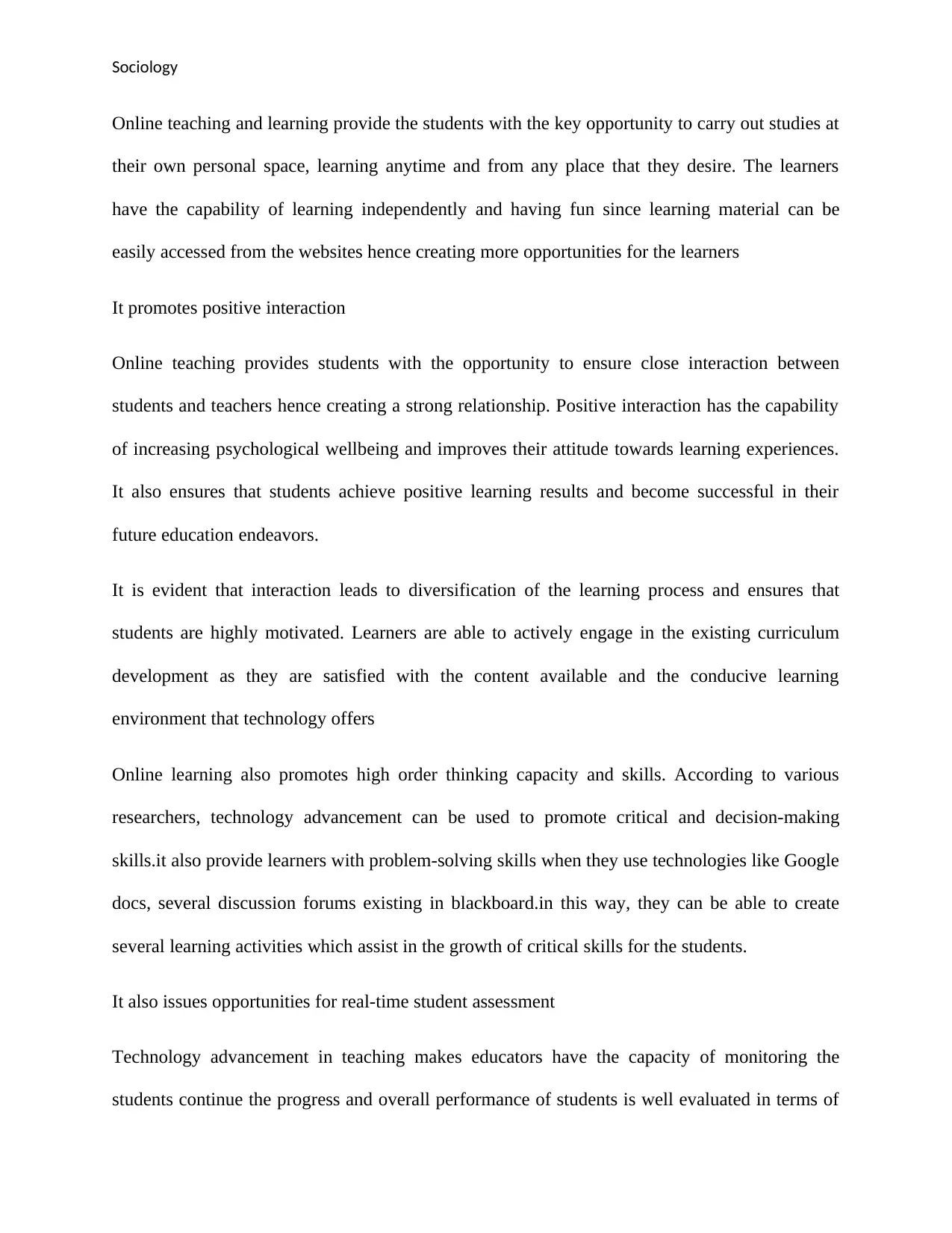
Sociology
Online teaching and learning provide the students with the key opportunity to carry out studies at
their own personal space, learning anytime and from any place that they desire. The learners
have the capability of learning independently and having fun since learning material can be
easily accessed from the websites hence creating more opportunities for the learners
It promotes positive interaction
Online teaching provides students with the opportunity to ensure close interaction between
students and teachers hence creating a strong relationship. Positive interaction has the capability
of increasing psychological wellbeing and improves their attitude towards learning experiences.
It also ensures that students achieve positive learning results and become successful in their
future education endeavors.
It is evident that interaction leads to diversification of the learning process and ensures that
students are highly motivated. Learners are able to actively engage in the existing curriculum
development as they are satisfied with the content available and the conducive learning
environment that technology offers
Online learning also promotes high order thinking capacity and skills. According to various
researchers, technology advancement can be used to promote critical and decision-making
skills.it also provide learners with problem-solving skills when they use technologies like Google
docs, several discussion forums existing in blackboard.in this way, they can be able to create
several learning activities which assist in the growth of critical skills for the students.
It also issues opportunities for real-time student assessment
Technology advancement in teaching makes educators have the capacity of monitoring the
students continue the progress and overall performance of students is well evaluated in terms of
Online teaching and learning provide the students with the key opportunity to carry out studies at
their own personal space, learning anytime and from any place that they desire. The learners
have the capability of learning independently and having fun since learning material can be
easily accessed from the websites hence creating more opportunities for the learners
It promotes positive interaction
Online teaching provides students with the opportunity to ensure close interaction between
students and teachers hence creating a strong relationship. Positive interaction has the capability
of increasing psychological wellbeing and improves their attitude towards learning experiences.
It also ensures that students achieve positive learning results and become successful in their
future education endeavors.
It is evident that interaction leads to diversification of the learning process and ensures that
students are highly motivated. Learners are able to actively engage in the existing curriculum
development as they are satisfied with the content available and the conducive learning
environment that technology offers
Online learning also promotes high order thinking capacity and skills. According to various
researchers, technology advancement can be used to promote critical and decision-making
skills.it also provide learners with problem-solving skills when they use technologies like Google
docs, several discussion forums existing in blackboard.in this way, they can be able to create
several learning activities which assist in the growth of critical skills for the students.
It also issues opportunities for real-time student assessment
Technology advancement in teaching makes educators have the capacity of monitoring the
students continue the progress and overall performance of students is well evaluated in terms of
⊘ This is a preview!⊘
Do you want full access?
Subscribe today to unlock all pages.

Trusted by 1+ million students worldwide
1 out of 22
Related Documents
Your All-in-One AI-Powered Toolkit for Academic Success.
+13062052269
info@desklib.com
Available 24*7 on WhatsApp / Email
![[object Object]](/_next/static/media/star-bottom.7253800d.svg)
Unlock your academic potential
Copyright © 2020–2025 A2Z Services. All Rights Reserved. Developed and managed by ZUCOL.





